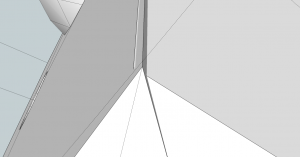If you’re a coder already, you’re gonna love OpenSCAD. When I mentioned to a friend I was thinking about messing around with OpenSCAD, I had never seen it used before, I had only heard mention of it as a powerful open source 3d CAD program. When he sent me back an email with his first OpenSCAD project and it looked like the code from a computer program, I was frightened and confused. And literally laughed out loud.
Two things then happened that made me take a serious look at it. 1.) I started reading Practical 3d Printers by Brian Evans. 2.) I got frustrated trying to making truly precise shapes in Sketchup.

Practical 3d Printers: The Art and Science of 3d Printing has a rather lofty sounding title, but is mostly very easy to read and to my knowledge one of the only very few books on the subject available thus far. It already seems slightly dated because of how fast the landscape is changing, but still very relevant for anyone just getting their feet wet.
It covers the hardware available from fully DIY RepRaps to “box bots” (preassembled machines), an overview of slicers and the printer software tool chain, a sampling of CAD programs, how to calibrate your printer, what upgrades to consider and a host of design projects. It really is a soup-to-nuts introduction to 3d printing and highly recommended.
The projects covered mostly use OpenSCAD and if one has the patience to follow the projects one step at a time, a great deal of understanding can be digested in bite size chunks.
Although I still recommend Sketchup for the sweet spot it finds between accessibility and modelling power, without some of the alignment tools found in the pro version (I’m just guessing here, I haven’t used it), making precisely modelled parts can be very frustrating, especially if you’re trying to mate components of any complexity. You can easily end up with open segments or sloppily aligned surfaces something like what you see below.
Realistically, if these errors are small, they can generally be easily fixed by netfabb cloud service and any residual misalignments will likely be well finer than my printing resolution, but they’re annoying and just don’t seem like the kind of inaccuracies one should have to put up with when designing 3d objects with a computer, you know?
This is where OpenSCAD comes in. If your model has gaps or imprecision, it’s because your code is wrong or your math is bad. Deal with it. To put it another way, if you can’t describe your object with a mathematical equation, do you really know what you’re talking about?

How complex do the OpenSCAD demos in the book get? Or, put another way, what’s the most sophisticated output Evans demos?
Not sure if I can link to page 153 this way, but this is the most advanced “from scratch” design in the book. The STL mash ups get pretty complex too however. I http://books.google.com/books?id=FPSsCTE9KpgC&pg=PA153&lpg=PA153&dq=%22Brian+evans%22+%22listing+6-8%22&source=bl&ots=bfBGkyRyri&sig=tt-4Mizv9u6BWbbYQSiKtFK6vuU&hl=en&sa=X&ei=yR4mUaX6OYjq0QGlgoHwDw&ved=0CC0Q6AEwAA